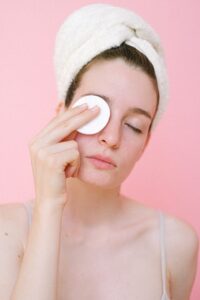Just when you think that a glowy tan is something that only the seaside got you covered with, you may want to think twice, because self-tan is equally picture-perfect, and you can achieve that right from the corner of your house. Knowing how to self-tan will save you time, money, excess UV rays damage, and anger (or whatever emotional pattern appears when a beauty product doesn’t work well).
Self-tanners are the ultimate glow beauty product. They’re safe, quite effective and they don’t necessarily make your pockets hurt. The downside of owning one? Not knowing how to apply it. That’s why we found faux tanners interesting enough to research and share the gospel with you.


How do Self-Tanners Work?
Self-tanners consist of an active ingredient called DHA (dihydroxyacetone), which acts as a coloring agent. What differentiates the product from being completely safe when compared to natural sun exposure, is that the DHA interacts only with the outermost layer of the dead skin cells.
It takes 6-10 hours for the self-tanner to set in completely, which means the hue will get deeper as it dries.
As much as faux tanners are a safe substitute for harmful UV radiation, it is best advised to address the product application with your dermatologist, just in case you’re prone to any skin condition.
The pro-longevity of self–tanners is equal to your will of keeping it alive if you follow the ordered instructions below correctly.
What Are the Different Types of Self-Tanner Formulas?
- Self-Tanning Lotions have that creamy formula that makes them easy to apply, delivering a long-lasting promising tan.
- Self Tanning Sticks work best as face self-tanners, keeping all the mess away with a single sweep. Being very practical, this face self-tanning formula delivers a great sun-kissed effect.
- Self Tanning Mousse is best applied with a self-tanning mitt, and the bronze this lightweight, foaming self-tanning formula has will keep people wondering if a natural beach tan is nothing but the next best thing.
- Self Tanning Towelettes are your traveling buddy, and in addition to that, they’re pretty deceiving on whether you caught an actual tan or not. These single-use self-tanning wipes are your best bet.
- Self Tanning Mists are very hydrating, and they work by spritzing the product -which is a liquid formula- onto the skin.
- Self-Tanning Face Drops reassure that the self-tanning beauty market went all-in, and that means no body or face part gets left behind. It’s important you choose the right product for your face since the skin is quite sensitive in this area, and self-tanning drops got you covered on that.
How to Self Tan?
1. Exfoliate and Shave the Skin
Exfoliating the skin is key to having an even, buildable tan. Make sure the dead skin cells are removed smoothly for a good faux-tanner application, especially on the rough parts of your skin like your knees or elbows.
However, no matter how much of a good deal exfoliating is, you should not proceed with self-tan right after this skincare duty. You should give your skin time to rest or the tanner will not perform well.
If you also practice shaving your body hair, or other hair removal treatment, you should consider doing so before you apply the self-tanner (at least 24 hours prior), so the tint will be buildable and non-streaky. A silky finish is always the goal.
Touching on hair removal treatments, self-tanner should not be applied in the first two weeks of laser hair removal, since the skin is pretty delicate during such a period.
2. Dry Your Skin Before
For proper faux-tanner use, make sure your skin is completely dry so it absorbs the product accordingly. You should not tan right after you shower, so steer clear of the product application for at least the first 10 minutes. If a shower before your appointment is a must, avoid hot water as much as possible. No body wash product or shampoo should be used during the shower.
3. Apply the Product
Your self-tanner should be applied in a sweeping motion, so the pressure is evenly applied on each part of the skin, and the appearance of the product ends up looking buildable, balancing out all hues.
You should start by applying self-tanner on your arms, and legs, and then you go forward on the torso, making sure every exposed body part gets a good, consistent amount of product.
Remember, the ‘less-is-more’ formula doesn’t necessarily apply to self-tanner, because when you apply it in small amounts, the product will be more likely to oxidize and leave streaks. Be generous when faux-tanning, but also keep in mind that you can always choose to gradually build or layer the tan according to your liking.
4. Apply With a Self-Tanning Mitt
Hands might not do well when applying the self-tanner because it usually does fetch up to a story of mess and uneven strokes. But if that’s what works for you, you do you!
Self-tanning mitts are preferred to be used during the application process so the formula (which in this case is foaming) gets spread correctly and way faster on the skin, because of the larger surface area it has when compared to hands.
Another alternative to a self-tanner mitt could be robber gloves because they don’t also absorb any product.
5. Clean Up the Excess Product on Your Joints
Your knees, ankles, and elbows absorb more product than the rest of your skin, so it’s best to dilute the product from such areas for an even application. You can use a soft velour towel on a pat-drying motion or you can simply apply lotion, so the self-tanner residue dims a little, for the tint to appear even with the rest of the skin.
6. Wash Your Hands
Even if you used a mitt or any other self-tanning applicator, make sure you wash your hands right away since they tend to soak up the orange hues.
7. Wait for the Product to Dry
Your self-tan will be as good as you decide for it to be. And it requires a little bit of patience.
You should let the self-tanner dry completely, not teasing the skin with clothes for at least 20 minutes. Showers, and any kind of intense contact with water, should also be completely avoided for the first 8 to 12 hours. In the first 24 hours of your self-tanning application, make sure you do not use any body wash products such as loofahs, scrubs, gels, or even body shampoos.
It is advised to not wear tight clothes or underwear after self-tanning, since they may cause marks. Try to avoid sweating and find loose clothes to wear.
If in a rush, you can use a hairdryer on its cold setting to let the product dry well.
Shaving right after self-tanning is a total deal breaker, because the dead skin cells will be removed, and so will the tan.
And yeah, you can sit after applying your self-tan, as long as you don’t rub the tan with any harsh cloth material.
8. Moisturize and Maintain the Glow
Moisturizing your entire body is crucial- for a long-lasting tan (but only after you wait for the product to dry completely as explained above), because it offers hydration that doesn’t let the skin get cracked or flaky, and allows the product to sit well, not being greasy at all.
It is also important to know that self-tanners do not have sun-protecting properties, so it’s always a good idea to use sunscreen if the sun’s out and you’re wearing a homemade tan.
How to Apply Self Tanner on the Face?
You can apply the faux-tanner on the face with a mitt or your bare hands, assuming you’re not putting a large amount of product on this area, since it doesn’t require doing so. The self-tanner application process explained previously is appealing to the face tan too.
The use of self-tanner as foundation gives a completely chiseled, tanned look on those summer days, making foundation-free skin a total slay.
It’s always beneficial to do your skincare routine properly before applying self-tanner on the face.
The Takeaway
Things to keep in mind when choosing a self-tanner would be the product consistency based on the formula you go for and the hues of the product, because it is so easy for it to oxydize and not end up how you want it to. No matter the choice, the tan is supposed to be spread smoothly and evenly, with no strokes left behind.
Most self-tanners also have that shimmery finish that gives that last touch of razzle-dazzle, making the product a must-have in your beauty regime.
FAQs
How Does Self-Tanner Work?
Self-tanners work by reacting with the top layer of your skin, thanks to the active ingredient DHA (dihydroxyacetone), producing a temporary tan appearance.
Will Self-Tanner Make Me Orange?
Modern self-tanners are formulated to minimize the risk of an orange tone, especially when choosing the right shade for your skin tone and applying it properly.
How Long Does Self-Tanner Last?
Self-tanner typically lasts around 5 to 7 days, varying based on factors such as skin type, skincare routine, and pre-application exfoliation and moisturization.
Can I use Self-Tanner on My Face?
Yes, there are self-tanners specifically designed for facial use. Choose a suitable facial self-tanner and ensure even application for a natural look.
How Long Does it Take for Self-Tanner to Develop?
The development time varies depending on the product, but some self-tanners show color within a few hours. Follow the instructions provided with your chosen self-tanner for best results.



